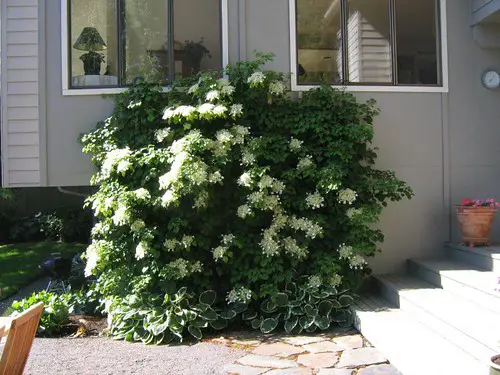The climbing hydrangea is a striking and versatile plant that brings beauty and elegance to any garden. Known for its lush green foliage and delicate lace-cap flowers, this woody vine is a favorite among gardeners looking to add vertical interest to walls, fences, or other garden structures.
Climbing hydrangea can grow slowly initially but becomes more vigorous as it matures, eventually reaching significant heights. Its attractive bark, large, serrated leaves, and fragrant blooms make it a pleasing addition throughout the year.
Native to Asia, the climbing hydrangea is hardy and adaptable, flourishing in a variety of conditions. It is valued not only for its visual appeal but also for its ability to thrive in shady areas where other climbers might struggle. Its dense growth habit also makes it a valuable screen or cover in landscape design.
| Attribute | Details |
|---|---|
| Common Names | Climbing Hydrangea |
| Botanical Name | Hydrangea anomala subsp. petiolaris |
| Family | Hydrangeaceae |
| Plant Type | Deciduous Vine |
| Mature Size | 30-50 feet |
| Sun Exposure | Full Sun to Part Shade |
| Soil Type | Well-drained, Fertile, Moist |
| Hardiness Zones | 4-8 |
| Native Area | Eastern and Southern Asia |
Climbing Hydrangea Care
Caring for climbing hydrangea requires attention to its specific needs, particularly during the establishment phase. Once established, this plant becomes relatively low-maintenance but benefits from regular pruning and support.
Proper planting and site selection play a significant role in its growth and development. Providing the climbing hydrangea with the space and structure it needs to climb ensures a healthy and attractive display.
Light Requirement for Climbing Hydrangea
Climbing hydrangea thrives in a range of light conditions from full sun to partial shade. While it can grow in full shade, too little sunlight can reduce flowering. A location with morning sun and afternoon shade often provides an ideal balance.
Soil Requirements for Climbing Hydrangea
This plant prefers well-drained, fertile, and consistently moist soil. While it can tolerate a range of pH levels, slightly acidic to neutral soil (pH 5.5-7) is ideal. Amending soil with organic matter improves drainage and fertility.
Water Requirements for Climbing Hydrangea
Climbing hydrangea requires consistent moisture, particularly during its establishment phase. Deep and infrequent watering encourages deep root growth. Mulching helps retain soil moisture and maintain even soil temperature.
Temperature and Humidity
Climbing hydrangea is hardy in USDA zones 4-8 and can tolerate winter cold in these areas. It appreciates humidity, especially during hot and dry periods. Providing adequate water and mulch can help maintain the necessary humidity levels.
Fertilizer
A balanced slow-release fertilizer applied in early spring supports healthy growth and flowering. Avoid over-fertilizing, as excessive nitrogen can inhibit blooming.
Pruning Climbing Hydrangea
Pruning is not essential but can keep the plant tidy and manageable. Pruning should be done in late winter or early spring before new growth begins. Remove dead or unhealthy wood and trim to shape as desired.
Propagating Climbing Hydrangea
Climbing hydrangea can be propagated through softwood cuttings taken in late spring or early summer. Rooting hormone can enhance success, and cuttings should be kept moist and shaded until roots develop.
How To Grow Climbing Hydrangea From Seed
Growing climbing hydrangea from seed is a lengthy and less common method. Seeds should be sown indoors in late winter and stratified for up to 3 months before planting. Germination can be erratic, and growing from cuttings or purchasing young plants is often preferred.
Common Pests & Plant Diseases
Aphids
Aphids can be managed with insecticidal soap or natural predators.
Powdery Mildew
Adequate spacing and avoiding overhead watering help prevent powdery mildew.
Common Problems With Climbing Hydrangea
Slow Growth
Young plants often grow slowly, which can be concerning to gardeners. Patience and proper care will result in more vigorous growth in subsequent years.
Failure to Bloom
Inadequate sunlight, over-fertilizing, or pruning at the wrong time can result in a lack of blooms.
Pro Tips
- Choose a strong support structure as mature plants can become quite heavy.
- Monitor soil moisture regularly, especially during dry periods.
- Allow the plant time to establish; growth may be slow initially but will become more vigorous.
- Avoid planting in areas with harsh afternoon sun to prevent leaf scorch.




